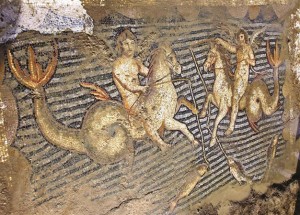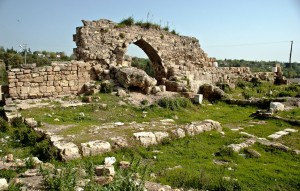This small city of Misis located in Turkey like most cities is located near water ways. This city was located on the silk road at one point. This city has a rich history and up to 100,000 city inhabitants lived there at one time. Misis now has a population of just a few thousand and is a small village known as Yakapinar. This city was restored to its former glory with the discovery of mosaics in the Misis mound. These mosaics show the vast amount of animals that were imported into the city. These mosaics show that we still repeat many of the actions of past societies. One mosaic includes a way of caging poultry the same way the locals still do.
This former city was known as the immortal city, not because of its age, but because of the reference in the Quran where the recipe for immortality was dropped into the river from this location. Through the recent excavation new mosaics, a stone bridge and the Havraniye Caravanserai were unearthed. The Havraniye Caravanserai is a center for commerce; the only thing that remains of it now is the large gate to its entrance. The excavations show how the city has changed hands so many times. The artifacts found are from the Neolithic, Roman, Byzantine, and Armenian eras.
Misis is similar to modern cities such as St. Louis and Detroit which were at one point large economic centers and are now decreasing rapidly in population. The village of Yakapinar was also a huge economic center but the population fell due to external conflicts such as the crusades and the city being burned down.
The government of Turkey has set up plans to keep the village and area alive by giving out incentives to maintain normal life there as well as build new housing complexes to allow people to move back to this area. The head archaeologist believes that this will be a hot spot in tourism because of the variety of different cultures that have influenced the area over time.

The only Mosaic known to show Eros in this manner
The mosaics discovered from this excavation as well as the original ones in 1956, show what the culture at that time felt was most important. There is a Noah’s Ark mosaic, and one of eros the greek/roman god of love. The mosaics and the Roman and Byzantium ruins hold a lot of aesthetic value which unfortunately cause their true meanings to be forgotton. The latest digs discovered more about the culture and the extent of the city’s history going back past the fifth millennium. The original excavation in the 1950’s appears neglected everyday life and why the city fell, and instead appreciates the aesthetic value of these ruins.

This is the ruins of the market place of Misis
From text it seems that the reason this city was able to survive for so long was its stable economic location. Its proximity to a river and the Mediterranean and to the middle east (Israel) allowed for this city to maintain a strong economic center with multiple markets. The small village still has modern inhabitants just like the desolate cities of the American Midwest. This “immortal” city of Turkey shows how archaeology should be able to help understand how cities rapidly fall in population, but with the original excavation more focused on aesthetic value, it is the recently discovered artifacts and ruins which will help us correct the past mistakes and help us understand what life was like in this economic center and how the external conflicts caused the population to decrease.
Work Cited:
Yale, Pat. Turkey From the Inside. N.p., n.d. Web. 16 Nov. 2014. <http%3A%2F%2Fwww.turkeyfromtheinside.com%2Fplaces-to-go%2Fm%2F1390-misis-yakapinar.html>.
“ARCHAEOLOGY – Turkey’s Immortal City Gets New Lease on Life.” Turkey’s Immortal City Gets New Lease on Life. N.p., 14 Nov. 2014. Web. 16 Nov. 2014. <http://www.hurriyetdailynews.com/turkeys-immortal-city-gets-new-lease-on-life.aspx?PageID=238&NID=74276&NewsCatID=375>.
Images:
Halicioglu, Seref. Misis Kervansarayı (Misis Caravanserai). Digital image. Panoramio. N.p., 10 Sept. 2014. Web. <http://www.panoramio.com/photo/111594837>.
Eros Mosaic. Digital image. Eros Mosaic Found in Southern Turkish City. Doğan News Agency, 20 Feb. 2013. Web. 16 Nov. 2014. <http://www.hurriyetdailynews.com/eros-mosaic-found-in-southern-turkish-city.aspx?PageID=238&NID=41523&NewsCatID=375>.
additional reading:
Observations on the Samson Floor at Mopsuestia; This article not only gives a good history of the city but goes into detail about some of the mosaics discovered. http://www.jstor.org/stable/1291337?seq=3





